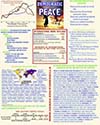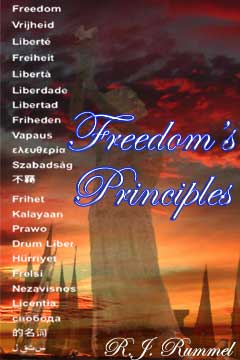I finally have read Joanne Gowa’s often quoted, Ballots and Bullets: The Elusive Democratic Peace. She does a statistical analysis (Poisson and probit, Chi-square and other significance tests) of war and militarized disputes (MIDS data), 1816-1980. She turned each year for each pair (dyad) of states over this period into a case to be analyzed. She ended up with 30,963 democratic to democratic dyad years, and 275,807 for other dyads.
She finds that out of 307 dyad years of war, seven involved democratic dyads. But, these seven were the Spanish-American war, and the six “wars” of Finland versus the democratic Allies in World War II. None of these are really wars between democracies. Spain was not a democracy in foreign policy, which was made by the King, and Finland allied itself with Germany in order to fight the Soviet Union. It fought no battles with the democracies. So, in reality, there were no wars fought between democracies over the long span of 174 years. But, also in the MIDs data, I know that there is only one case of violence between democracies over this period, which is the marginally democratic Ecuador (initiator) vs. the U.S. in 1954 in which between 1 and 25 were killed.
Then, how does Gowa make this claim for what she has been most quoted?
I find that the democratic peace exists only during the Cold War. No evidence of a democratic peace exists before World War I. I conclude that an explanation based on shifting interests is more consistent with this dispute-rate pattern than is an explanation based on common politics. Thus, for example, the advent of relative peace between democratic states after 1945 can be interpreted as a product of the interest patterns that the advent of the Cold War induced.
This suggests that the logic and evidence that support a foreign-policy strategy of enlargement are based on a unique and now extinct era in world politics (p. 3).
Gowa published her book in 1999, and she aimed this at then President Clinton’s third foreign policy goal of spreading democracy (he was also converted to the democratic peace), and is even more relevant today (and for the reason Gowa has been now so quoted) regarding President Bush’s singular Forward Strategy of Freedom.
Even though there has been a sharp increase in the number of democracies since the Cold War ended, and since there still has been no war between them, she is manifestly wrong. But, she is still quoted, and her claims still apply to the years before the Cold War.
Gowa’s conclusion seems strange, given that over the 174 years of her data there was no war between democracies, and only one case of violence causing at most 25 dead. She does it through statistical obscurantism (my tennis was out on the left, and the next one on the right, but what the hell, on the average I was getting them in right down the center of the court). First, she divides the data into three periods, pre-1914, 1919-1938, post-1945, eliminating from the analysis World Wars I and II. Then she applies statistical analysis to the wars to determine if the lack of wars between democratic dyads is significant, holding constant whether the dyads are contiguous and their major power status. Only in the case of the post-1945 wars and MIDS is democracy “significant.” Moreover, only in this period do democracies “significantly” enter into defense treaties with each other.
What is going on here? First, it is a social science convention to apply tests of significance to any relationships between data. There are times when this is appropriate and useful, and I have done it often in my studies, but there are also times, hardly recognized, when it obscures what the data mean. Here, Gowa has covers cases for 174 years — not a sample, but what statisticians call the universe. Then a simple tabulation of the cases of war and nonwar between democracies and others would have been instructive. But, Gowa wanted to go further. She wanted to test the possibility that the lack of war between democracies could have occurred by chance. She finds that except for the post-1945 period, the lack of war for prior periods could have been a chance result (technically, she could not reject the null hypothesis that democracy had no effect).
But, she neglects two things. One is that her results were predicted by democratic peace theory, and second, they are consistent with the results of other democratic peace studies. If studies a, b, c, … come up with the same results, one should not then isolate any one of the studies as a unique event that may have occurred by chance. If the data of each study are independent of the data used in the other studies, then the likelihood of getting a probability p of chance cross all the studies would be a multiple of all the p of their significance tests.
She can respond that what she did is in fact unique, which was to divide the tests into periods. But, the zero for wars between democracies for the 174 years has to be true for any periodization of the data. What happens when she so subdivides her data is that the “sample size” decreases, and the zero wars become insignificant. For example, for 1919-1938 there were zero wars between democracies for 5,919 democratic dyads, and three wars for 31,483 other dyads, which testing the significance of this distribution by chi-square, yields a nonsignificant p of .17. That is, if the study were done 100 times, seventeen or less of them would result in no difference between democratic and nondemocratic dyads. This is too high for social scientists, who much prefer a probability of .05. Therefore, Gowa claims that in the interwar years, it is not possible to reject the “null hypothesis” of these results being by chance. Taking account of similar results for the pre-World War I period, she then interprets such statistics to say, “I find that the democratic peace exists only during the Cold War.”
Well, correcting for her seven misclassified cases of wars between democracies I mentioned, all I can say is that zero wars for democracies is zero wars, and no one has yet shown there to be a case of undoubted war between undoubted democracies. And, all periodizers should note, this zero will not change regardless of the period of history unless true exceptions to the democratic peace are found.
Other Books I’ve Read Recently
Yoshida Mitsuru, Requiem for Battleship Yamato, translated by Richard H. Minear (1985). A diary like report of one of the few survivors of the planned suicide voyage (and known to be such by the sailors) of the world’s largest, most powerful battleship. To me, the importance of this book is to help explain why this death voyage was ordered and what the men on board thought about it. It is a mistake to liken the terrorist murder bombers in the Middle East to these Japanese warriors. For them, it was emperor, country, duty, and honor. For the terrorists, it is to kill Americans, Jews, or infidels.
Yoshimura, Akira, Battleship Musashi: The Making and Sinking of the World’s Biggest Battleship, Translated by Vincent Murphy (1991). The Musashi was built on the same plans as the Yamato. Most interesting is the international and Japanese politics of their construction, and as in the book above, the final bomb-by-bomb, torpedo-by torpedo destruction of this unsinkable behemoth.
Williams, Glenn F., Year of the Hangman: George Washington’s Campaign Against the Iroquois (2005). During the France and British Wars in North America, Indian tribes fought on both sides. They did so also during the Revolutionary War, with the Iroquois Confederacy fighting with the British. They attacked and massacred along the frontier in order to draw off Washington’s forces and weaken his army facing the British. Those who constantly condemn American’s killing of Indians seem not to know about the Indian democide, the various wars involving the Indian tribes against each other, and their fighting as allies to the British, French, and Spanish.
Levitt, Steven D. and Stephen J. Dubner. Freakonomics: A Rogue Economist Explores the Hidden Side of Everything (2005). This really should be titled the use of numerical analysis too uncover truth, such as corruption among teachers and Sumo wrestlers, why drug dealers live with their mothers, and why has the Supreme Court decision in Roe versus Wade caused crime to steeply decline. I would add, which is not in this book, how numbers have established and then persuaded a discipline and presidents as to the democratic peace.
Rowan, Roy. Chasing the Dragon: A Veteran Journalist’s Fisthand Account of the 1949 Chinese Revolution (2004) If you want to know how American “old China hands” grew to hate Chiang Kai-chek, while soft pedaling the atrocities of Mao, and thus influencing American policy, Rowan’s account of his experience in post World War II China helps. This is a particular interesting book to read after Chang and Halliday’s Mao.



 Posted by rudyrummel
Posted by rudyrummel 






